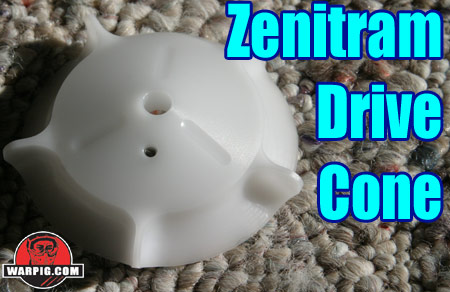  |
|
|
|
|
|
|
  |
|
|
|
|
|
|

What
do you think?
|

Zenitram HALO Drive Cone By Bill Mills - April 2005 There is no doubt about it, that Odyssey has made its mark on the tournament paintball scene with the HALO force-feed loader system. As popular as it is, there are still those who run into occasional problems with their HALO. One issue cited is breaking of the drive cone. The drive cone looks somewhat like a roulette wheel, and sits in the center of the HALOís catch cup. A motor and belt drive system in the HALO keeps a drive spring under constant tension so that the drive cone is always ready to use its five blades to push paintballs around the catch cup, through the feed tube and into the paintball gun.
Zenitram Manufacturing addresses both of these potential failure points with their HALO Drive Cone. Rather than being injection molded, Zenitramís cone is billet machined from a single piece of white acetal resin. Instead of protruding from the cone with squared off corners, Zenitramís fins have fillets. Their interior corners are rounded, giving them additional strength. At the key potential failure point, Zenitram uses a stainless steel pin to link the drive cone to the drive spring.
For testing, the Zenitram HALO Drive
Cone was placed in a HALO B with Victory Board, and showed no signs of
problems. It fed properly, as did the stock drive cone, but with
its beefier connection to the drive fins, and solid link pin in the drive
gone, the chances of this HALO failing have been reduced.
|
| Copyright © 1992-2019
Corinthian Media Services. WARPIG's webmasters can be reached through our feedback form. All articles and images are copyrighted and may not be redistributed without the written permission of their original creators and Corinthian Media Services. The WARPIG paintball page is a collection of information and pointers to sources from around the internet and other locations. As such, Corinthian Media Services makes no claims to the trustworthiness or reliability of said information. The information contained in, and referenced by WARPIG, should not be used as a substitute for safety information from trained professionals in the paintball industry. |